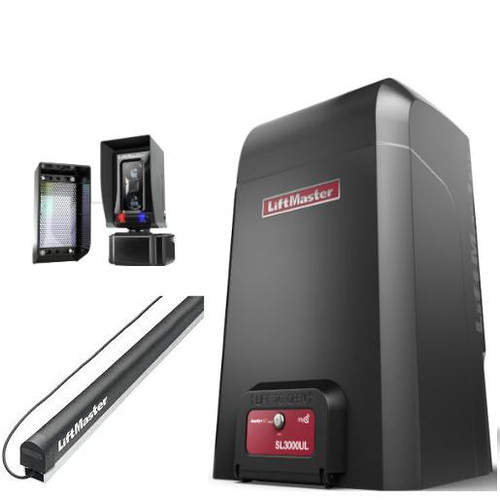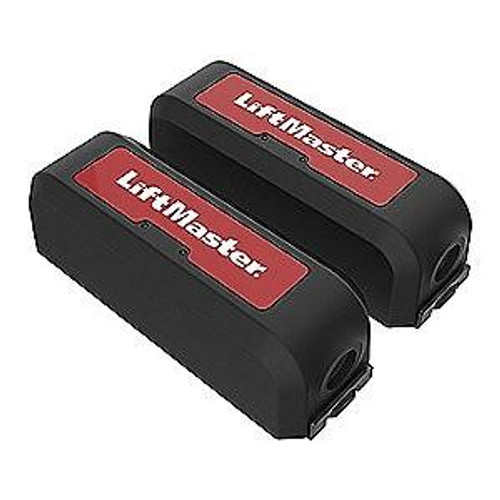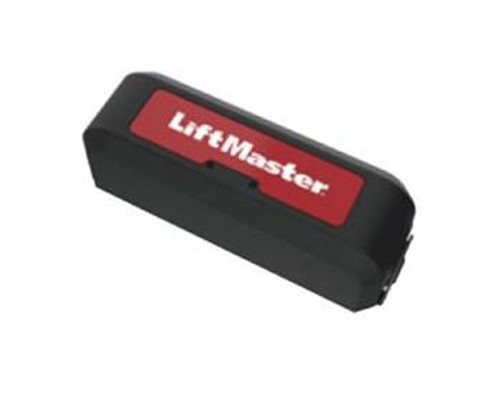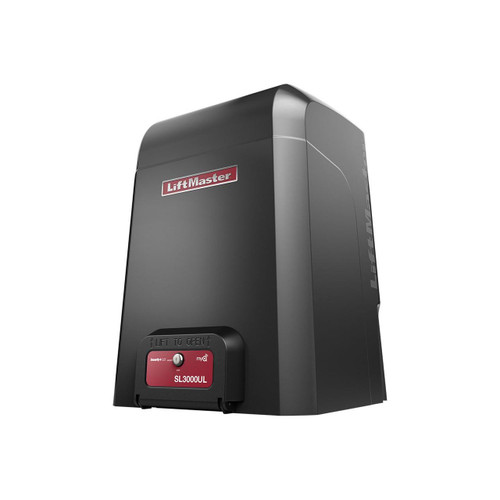Elite SL3000 Now Elite SL3000501UL (replaces the SL3000501U)
Updated unit complies with new UL325 code revised Aug 2018
System now requires monitored secondary entrapment devices
unit will include LMRRU safety photo eye and 5 ft safety edge for rear of gate as well as 20 feet of drive chain
Suggest LMWEKITU sold separately if wireless edge connection is desired
ELITE SL-3000 Heavy Duty slide gate operator 1/2 HP Now includes built in Liftmaster receiver. Use Liftmaster 893MAX remotes sold separately.
SL3000 Brochure (click here)
Title: Elevate Security and Efficiency with Liftmaster SL3000501UL Commercial Slide Gate Operator
Meta Description: Enhance security and streamline access control with the Liftmaster SL3000501UL commercial slide gate operator. Designed for heavy-duty usage, this operator offers reliable performance, advanced features, and easy integration for commercial properties.
Introduction: Upgrade your commercial property's security infrastructure with the Liftmaster SL3000501UL commercial slide gate operator. Engineered for robust performance and durability, this gate operator is ideal for high-traffic areas where access control and reliability are paramount.
Key Features:
- Heavy-Duty Construction: Built to withstand demanding environments, the SL3000501UL boasts durable materials and construction, ensuring years of trouble-free operation.
- Advanced Security: Safeguard your property with advanced security features such as Security+ 2.0® technology, which provides a secure signal and helps prevent code grabbing.
- Smooth Operation: Experience smooth and efficient gate operation thanks to the powerful motor and precision engineering of the SL3000501UL.
- Easy Integration: Seamlessly integrate the gate operator with existing access control systems for enhanced convenience and functionality.
- UL-Listed for Safety: Rest easy knowing that the SL3000501UL is UL-listed for safety, meeting rigorous industry standards.
Benefits:
- Enhanced Security: Protect your property and assets with reliable access control and monitoring.
- Improved Efficiency: Streamline entry and exit procedures, reducing wait times and improving traffic flow.
- Long-Term Reliability: Invest in a gate operator designed for longevity and consistent performance, minimizing maintenance costs and downtime.
- Customizable Options: Choose from a range of accessories and add-ons to tailor the SL3000501UL to your specific security needs.
Elevate the security and efficiency of your commercial property with the Liftmaster SL3000501UL commercial slide gate operator. With its robust construction, advanced features, and seamless integration capabilities, this operator is the ideal choice for businesses seeking reliable access control solutions.
Contact us today to learn more about how the Liftmaster SL3000501UL can enhance security and streamline access control at your commercial property.
31 Main control board has experienced an internal failure. Disconnect all power, wait 15 seconds, then reconnect power (reboot). If issue continues, replace main control board.
35 Max-Run-Time Exceeded Error Check for an obstruction, then reprogram the limits.
36 Product ID Error Was the control board just replaced? If so, erase limits, enter limit setup mode and set limits. If not, disconnect all power, wait 15 seconds, then reconnect power before changing product ID harness.
37 Product ID Failure Unplug product ID harness then plug back in. Disconnect all power, wait 15 seconds, then reconnect power before replacing product ID harness.
43 Exit Loop Error Failure or missing loop (SHORT or OPEN - LiftMaster Plug-in Loop Detector only) Check loop wiring throughout connection. May be a short in the loop, or an open connection in the loop.
44 Shadow Loop Error
45 Interrupt Loop Error
46 Wireless edge battery low Replace batteries in wireless edge.
47 Power board fault Relay fault detected in the power board. Replace the power board.
50 Run-Distance Error The limits are less than the minimum requirement or longer than what was learned. Check limit positions and proper switch function. Run- distance can be re-learned by setting the handing again.
53 Brownout occurred AC/DC board supply dipped below allowable level. Review power supply and wiring. If rebooting, ensure enough time for discharge of power to force a fresh boot.
54Wireless Second Operator Communication Error Check the second operator for power. If OFF, restore power and try to run the system. If powered, deactivate the wireless feature and then re-learn the second operator.
55 System AC Overvoltage Call utility.
56 System AC Undervoltage Check wiring and wire gauge to operator.
57 Limit Error - Stuck Switch Check switch for proper operation. Check harness for shorts. Replace if defective.
58 Limit Error - Wrong Switch Check motor wiring.
59 Missing Power Board Check harness for shorts. Check for presence of power board.
60 Minimum number of monitored entrapment protection devices not installed. Review monitored entrapment protection device connections. Slide gate operators require a minimum of two external safety devices; one in the close and one in the open direction.
61 CLOSE EYE/INTERRUPT held more than 3 minutes Check wired input on main control board; check for alignment or obstruction.
62 CLOSE EDGE held more than 3 minutes
63 OPEN EYE/EDGE held more than 3 minutes
64 CLOSE EYE/INTERRUPT held more than 3 minutes Check wired input on expansion board; check for alignment or obstruction. The photoelectric sensors may be installed too far apart.
65 CLOSE EYE/EDGE held more than 3 minutes
66 OPEN EYE/EDGE held more than 3 minutes
67 Wireless edge triggered more than 3 minutes Check wired input for wiring issue or obstruction.
68 Wireless edge loss of monitoring Check wireless edge inputs.
69 Wireless edge triggered IF an obstruction occurred, no action required. If an obstruction did NOT occur, check inputs and wiring.
70 CLOSE EYE/INTERRUPT triggered, causing reversal, preventing close, or resetting TTC IF an obstruction occurred, no action required. If an obstruction did NOT occur, check alignment, inputs, and wiring on main control board
71 CLOSE EDGE triggered, causing reversal, NO preventing close, or canceling TTC
72 OPEN EYE/EDGE triggered, causing reversal or preventing opening
73 CLOSE EYE/INTERRUPT triggered, causing reversal, preventing close, or resetting TTC IF an obstruction occurred, no action required. If an obstruction did NOT occur, check alignment, inputs, and wiring on expansion board.
74 CLOSE EYE/EDGE triggered, causing reversal and preventing close or canceling TTC
75 OPEN EYE/EDGE triggered, causing reversal or preventing opening
80 Close input (EYE/EDGE) communication fault from other operator Check inputs and communication method between operators, either wired bus or radio. Ensure operator is powered. May have to erase the wireless communication and reprogram the two operators.
81 Open input (EYE/EDGE) communication fault from other operator
82 Close input (EYE/EDGE) communication fault (expansion board) Check the connections between the main board and the expansion board.
83 Open input (EYE/EDGE) communication fault (expansion board)
84 Non-monitored device detected on the wireless safety system Non-monitored contact closure devices are not supported. Make sure connected devices are monitored. Check edges for proper orientation and resistive end cap connection.
91 Force Reversal (Operator 1) Check for obstruction. If no obstruction, check that the mechanical assembly is engaged and free to move. See section on Limit and Force Adjustment, and Obstruction Test.
93 RPM / STALL Reversal (Operator 1) Check for obstruction. If no obstruction, check the operator wiring and that the mechanical assembly is engaged and free to move. Replace APE assembly.
95 AC motor no start condition Motor start sequence failed. If the gate and motor are NOT moving, or moving too slow, check for an obstructed gate, binding in the mechanism, and relay board and start capacitor connections. If the gate and motor ARE moving, failure is due to loss of the encoder signal. Check the encoder cup and sensor on the limit shaft, and wiring.
96 Current Sensor Fault A fault was detected on the current sensor. Make sure the current sensor is connected to the main control board. Check the current sensor harness for an open or short. The operator will need a power cycle to resume operation after correcting the fault. If the fault continues, replace the power board.
99 Normal Operation No action required





![Liftmaster CSL24UL Commercial Slide Gate Operator with Battery Backup [CSL24ULMC] Liftmaster CSL24UL Commercial Slide Gate Operator with Battery Backup [CSL24ULMC]](https://cdn11.bigcommerce.com/s-32eq2wsbti/images/stencil/500x659/products/8309/233181/liftmaster-csl24ul-commercial-slide-gate-operator-with-battery-backup-csl24ulmc-csl24ul__71757.1724089762.jpg?c=2)





![Liftmaster KPW5 wireless keypad 5 code Security+ 2.0 [KPW5MC] Liftmaster KPW5 wireless keypad 5 code Security+ 2.0 [KPW5MC]](https://cdn11.bigcommerce.com/s-32eq2wsbti/images/stencil/500x659/products/12311/232196/liftmaster-kpw5-wireless-keypad-5-code-security-2.0-kpw5mc-kpw5__44304.1725051232.jpg?c=2)